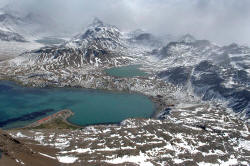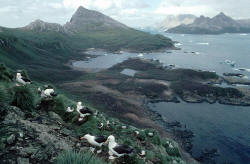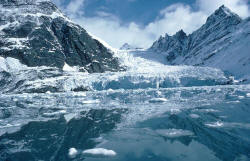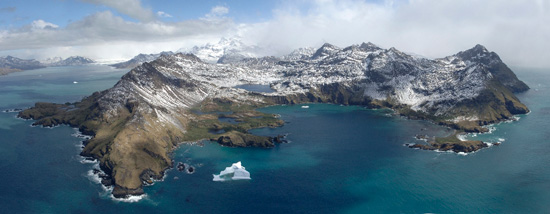|

January 2011
from
BritishGeologicalSurvey-BGS Website
Why is BGS
re-establishing a magnetic observatory on South Georgia?
The
South Georgia observatory will plug
a significant gap in the global network of magnetic observatories. In particular South Georgia observatory
will allow better monitoring of the South Atlantic Anomaly and of
changes occurring deep within the Earth.
By establishing the new
observatory,
BGS (British Geological Survey)
will re-start continuous magnetic observations in South Georgia,
last carried out in 1982.
|
 |
 |
 |
|
View towards
Mount Paget from the lower Bore Valley above Grytviken
View towards Mount Paget from the lower Bore Valley
above Grytviken. British Antarctic Survey © NERC |
King Edward
Cove and the abandoned Grytviken whaling Station
reflected in the waters of Cumberland East Bay, South
Georgia King Edward Cove and the abandoned Grytviken
whaling Station reflected in the waters of Cumberland
East Bay, South Georgia. British Antarctic Survey © NERC |
King Edward
Point Research Station & Grytviken Whaling Station in
Cumberland Bay, South Georgia. Looking South from high
above the Bore Valley King Edward Point Research Station
& Grytviken Whaling Station in Cumberland Bay, South
Georgia. Looking South from high above the Bore Valley.
British Antarctic Survey © NERC |
|
 |
 |
 |
|
View from
the Black-browed Albatross (Thalassarche melanophrys)
colony P2 above Evermann cove towards Bird Island
research station and South Georgia View from the
Black-browed Albatross (Thalassarche melanophrys) colony
P2 above Evermann cove towards Bird Island research
satation and South Georgia. British Antarctic Survey ©
NERC |
The glacier
dominated coastline of South Georgia. Harker Glacier,
Moraine Fjord, Cumberland East Bay The glacier dominated
coastline of South Georgia. Harker Glacier, Moraine
Fjord, Cumberland East Bay. British Antarctic Survey ©
NERC |
Stormy
weather in the mountains of South Georgia. Stormy
weather in the mountains of South Georgia. British
Antarctic Survey © NERC |
What is the
South Atlantic Anomaly?
The Earth’s magnetic field, generated deep within the planet, is a
shield against particle radiation from space. In the South Atlantic
this shield is much weaker than elsewhere across the globe and
radiation from space therefore penetrates deeper into the
atmosphere.
This region is known as the South
Atlantic Anomaly (SAA)
and the radiation in the SAA is a known hazard to satellites,
spacecraft and high-altitude aircraft.
Monitoring changes in magnetic field
The radiation input into the atmosphere depends on the Sun’s
magnetic and radiation activity and the geometry (or ‘shape’) of the
Earth’s magnetic field.
So, understanding the space environment,
particularly during magnetic storms, is important.
Equally important is understanding any
changes over time in the magnetic field observed across the surface
of the Earth - see also
Long-term monitoring of the Earth’s magnetic
field.
A magnetic reversal in progress?
The South Atlantic Anomaly
(SAA) is known to be growing in extent and spreading westwards from
South Africa, as the Earth’s internal magnetic field rapidly weakens
in this region.
This may be early evidence of a
forthcoming reversal in the direction of the Earth’s internal
magnetic field.
We do not know in detail precisely what occurs
during such reversals, including the changes observed in the
magnetic field and the time a reversal takes to complete. However
these factors are important in knowing where the radiation risk may
be increased and how the atmosphere might respond.
Earth’s magnetic field has had many highs, lows and reversals in its
past. The last reversal was around 800,000 years ago. So the Earth
is known to be able to re-generate its field and has done so during
human pre-history.
Understanding the development of the SAA
may therefore be significant in understanding the reversal process
and its impact on life and the natural environment.
New South Georgia Magnetic Observatory
By establishing a magnetic observatory on South Georgia BGS
geomagnetists will specifically help to develop our understanding of
the SAA by:
Joined up monitoring
Directly observing changes in the SAA in a region (mid Atlantic
Ocean) poorly covered by permanent magnetic observatories.
In the
middle of the ocean only Ascension Island, Tristan da Cunha and St
Helena observatories can provide monitoring of the magnetic field
and its changes. We need to better relate observations of the SAA
made separately on the land masses of Africa and South America.
South Georgia observatory will therefore
be a key addition to this small network of observatories.
Improving predictions
Providing new data to
construct better mathematical models of the magnetic field.
Such models can be used to infer how the
flow of liquid iron in the outer core of the Earth is changing. This
fluid flow sustains our magnetic field and forecasting how it
changes in time will help improve predictions of future change in
the SAA.
Understanding the complete ‘Earth
System’
Promoting collaboration between
space scientists, concerned with Earth’s space environment, and
geoscientists, concerned with Earth’s other environments.
There are major communities of these
researchers both in the UK and internationally and the expertise of
both space- and geo-scientists are needed to fully understand the
complete ‘Earth system’.
Measuring, monitoring and modeling the
Earth’s magnetic field is a key aspect of this understanding and
that is BGS’ contribution to this endeavor.
Contact
Contact Alan Thomson for
more information about BGS Geomagnetism.

Image comprising a
series of pictures stitched to show
Myviken Bay looking
along the Bore Valley from the North,
South Georgia.
Image comprising a
series of pictures stitched to show Myviken Bay
looking along the
Bore Valley from the North, South Georgia. British Antarctic Survey
© NERC
|







